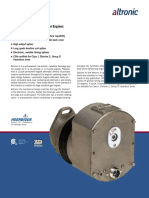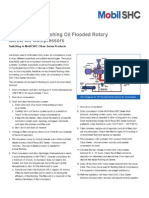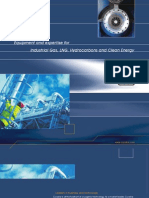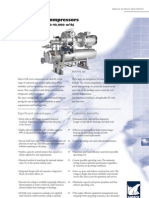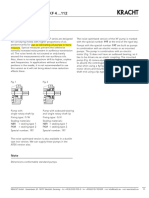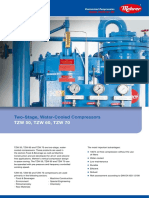Booster
Booster
Uploaded by
SergiSerranoCopyright:
Available Formats
Booster
Booster
Uploaded by
SergiSerranoOriginal Description:
Copyright
Available Formats
Share this document
Did you find this document useful?
Is this content inappropriate?
Copyright:
Available Formats
Booster
Booster
Uploaded by
SergiSerranoCopyright:
Available Formats
Aerzener Maschinenfabrik GmbH
Reherweg 28 / D-31855 Aerzen, Postfach 11 63 / D-31849 Aerzen, Tel.: 05154/810, Fax: 05154/81191
Operating Instructions
for
High-Vacuum Rotary Piston Blower HV
with sizes: GMa/GLa 10.0, 10.1, 10.2, 11.3, 11.4,
12.5, 12.6, 13.f7, 13.8
GMb/GLb 14.9, 15.10, 15.11, 16.12, 16.f13,
16.13, 17.15, 18.17, 19.19, 20.21
Roots Principle
Instructions for the transportation,
storage, installation, commissioning,
maintenance and cleaning
4PG-401EN
0368-002
07.98
page 1 of 14
EN
Aerzener Maschinenfabrik GmbH
Reherweg 28 / D-31855 Aerzen, Postfach 11 63 / D-31849 Aerzen, Tel.: 05154/810, Fax: 05154/81191
LIST OF CONTENTS
1.
1.1
1.2
1.3
Safety instructions
General
Points of safety
Spare parts and accessories
7.
7.1
7.2
7.3
Maintenance
General
Standard seals
Heatable vacuum blowers wHV
2.
General
3.
Notes on transportation
4.
Storage
8.
8.1
8.2
8.3
8.4
8.5
Lubrication
General
Qil lubrication qualities
Oil filling - transparent reservoir
Oil fillings
Oil change
5.
5.1
5.2
5.3
5.4
5.5
5.6
5.7
5.8
5.9
Installation
Preparation
Type of foundation
Preparing the foundation
Alignment
Anchoring bolts
Coupling and pulleys
V-belts
Final adjustment
Pipelines
9.
Blower - cleaning
10.
Change of flow direction
11.
Watercooled seal ring housing
12.
Spare parts list
13.
6.
6.1
6.2
Initial start-up
Test run of drive motor
Test run of blower
Mechanical load limits of the
Rough Vacuum blowers
Direct coupled speeds
V-belt-drive
4PG-401EN
0368-002
13.1
13.2
page 2 of 14
Aerzener Maschinenfabrik GmbH
Reherweg 28 / D-31855 Aerzen, Postfach 11 63 / D-31849 Aerzen, Tel.: 05154/810, Fax: 05154/81191
1.
Safety information
1.1
General
The Positive Displacement Blowers are constructed according to the latest technical standards;
the requirements of the German regulations for accident prevention VBG 16 are fulfilled.
Nevertheless, operating risks resulting from improper handling, inappropriate use or operation by untrained
personnel cannot be excluded.
These may result in injuries, as well as damage to the machines and production work.
In the users plant, anyone involved in the operation, maintenance and repair of the machines must have read and
understood the operating/maintenance manual, and in particular this safety information.
The machines must only be handled and operated by trained and authorized personnel.
Responsibility for the operation of the machines must be clearly defined in order to avoid uncertainties of
competence.
All work performed on the machines, including repairs, oil changes, maintenance etc. are to be carried out during
machine shutdown, with the electrical power supply to the compressor shut-off and locked out.
1.2
Recommendations - operator safety
- Working methods reducing the safe operation of the machine must be avoided.
- The user is responsible for ensuring that no unauthorized persons are in any way involved with the machine.
- Operating personnel have the obligation of advising their superior of any changes occurring to the machine and
which reduce the safety of its operation.
- The user is responsible for ensuring that the machines are operated when in proper working condition only.
- Management must inform operating personnel of the need to wear safety clothing, safety glasses, and hearing
protection.
- By means of appropriate procedures and controls, the user must guarantee cleanliness in the work
place and ease of access to and around the machines.
- Under absolutely no circumstances may safety devices be removed or disabled.
- Work on electrical components must be carried out by authorized persons only.
- While carrying out machine verification tasks, and in particular when opening the acoustic hood, the use of
hearing protection is compulsory.
- The discharge piping may reach a temperature of up to 150 C and must not be touched.
- Piping must not be disassembled prior to having been depressurized and purged with a neutral gas.
- Pressurized lube and instrumentation lines must not be opened, i.e. connections must not be tightened. There is
risk of injury, for example resulting from escaping oil.
- Machines conveying oxygen must remain free of grease and oil in the vicinity of the conveyed medium. There is
risk of fire and explosion.
- Extreme caution must be exercised in the case of internal combustion engine driven machines, given
the risk of poisening resulting from exhaust gases. The machine rooms must be sufficiently ventilated.
- In the case of machines operating in nuclear power plants, specific instructions apply. There is risk of radiation.
- Cleaning operations involving the use of sprays or cleansing agents must be carried out in accordance with the
relevant guidelines. There is risk of poisoning resulting from inhalation, and burns resulting from contact with
caustic substances.
- Safety devices, for example safety relief valves, coupling guards, belt guards, contact thermometers, and contact
switches, must not be removed or modified.
- Conversions and modifications not authorized by the manufacturer are not allowed for reasons of safety.
1.3
Spare parts and accessories
We expressly draw your attention to the fact that replacement parts and accessories not supplied by us are neither
tested nor approved by us. The integration or installation, as well as the use of such products can, under certain
circumstances, alter the original design characteristics of the equipment. We exempt ourselves from any liability
for damages resulting from the use of parts and accessories not supplied by us.
4PG-401EN
0368-002
page 3 of 14
Aerzener Maschinenfabrik GmbH
Reherweg 28 / D-31855 Aerzen, Postfach 11 63 / D-31849 Aerzen, Tel.: 05154/810, Fax: 05154/81191
2.
General
These rotary piston blowers (Roots principle), used in vacuum operation, are distinguished by the
letter "G". The subsequent letters "L" or "M" indicate the direction of flow.
The numbers, e.g. "14.9", indicate the model size. The letters "HV" following mean "high vacuum"
and the letter "m" following means "with auxiliary inlet".
coolant channel
water cooling at blower size
18.17 and above.
The radial sealing rings run on a hardened and ground shaft protection sleeve. The oil chamber
ensures that the radial sealing rings are vacuum-tight and have a long service life.
The level of sealing oil can be checked visually through the transparent oil tank. Oil must be always
be present. (see: Lubrication)
Concerning the blower types HV 18.17 to 20.21 the sealing ring casings at the driving shaft are to be
provided with cooling water. The connections are designed in G 1/4". All other blowers do not need
a water cooling.
External machined parts are coated with rust preventing varnish, and the inlet and outlet flanges
are fitted with plastic caps to prevent the entry of dirt and water spray.
4PG-401EN
0368-002
page 4 of 14
Aerzener Maschinenfabrik GmbH
Reherweg 28 / D-31855 Aerzen, Postfach 11 63 / D-31849 Aerzen, Tel.: 05154/810, Fax: 05154/81191
oil filter screw
main inlet
oil filler screw
oil tank
coolingwater
connection
water drain plug
oil level indicator
oil drain plug
discharge side
3.
Notes on transportation
3.1
3.2
3.3
The unit must be protected against jolts and impact during transportation.
When lifting the unit by crane, do not use the free ends of the shaft nor the cast eyes on the side
plates or the top of the housing: use instead a suitable hemp or wire rope sling placed around the
side plates.
When the unit arrives at its destination, check that it is undamaged and that the delivery is complete.
4.
Storage
If the units have to be stored before use, a dry, well protected space should be provided. If
necessary, the rust preventing varnish coating on the machined surfaces should be renewed, using a
rust preventing oil. If the unit has to be stored for a longer period and there is insufficient protection
from dampness, the smooth faces of the flanges and the interior chambers of the blower must be
coated with a conservation oil to prevent corrosion.
Protective oils:
External
TECREX 39 (MOBIL OIL)
RUST BAN 324 (ESSO)
V-Produkt 9703 (SHELL)
Oil chambers
ESSO LUB MZ 20 W/20
SHELL Ensis Motor Del 20
MOBIL Mobilarma 523 or 524
AVIA Avilub MK 2000
or other equivalent products offered by mineral oil manufacturers.
Cleaning agent: e.g. Certrex 62 from Mobil or Varsol from Esso.
5.
Installation
4PG-401EN
0368-002
Conveying chamber
Ballistol-oil
(biodegradable, no ground
water contamination)
page 5 of 14
Aerzener Maschinenfabrik GmbH
Reherweg 28 / D-31855 Aerzen, Postfach 11 63 / D-31849 Aerzen, Tel.: 05154/810, Fax: 05154/81191
5.1
Preparation
Before transporting the unit to the prepared base, all surfaces which will come into contact with the
base should be cleaned of oil and grease to ensure proper contact.
Leave the plastic caps on the flange until the pipework is ready to be finally connected.
5.2
Type of foundation
Rotary piston blowers should be mounted on a flat, vibration-free foundation. The dimensions for the
foundations should be taken from our drawings. If the unit is to be located on a steel structure or a
deck which is capable of vibrating, then we recommend that it be mounted on elastic machine feet
which absorb transmitted noise; in this case, the blower and its drive motor are mounted on a single
common steel base frame, a cast concrete bed slab, laid on rubber blocks, is also suitable.
Mounting on flexible elements
a) steel base frame and
b) concrete bed slab
elastic machine feet
on rubber blocks
c) steel tubes cast into the base make
handling and transport easier
5.3
Preparing the foundation
The surface of the foundation should be roughened and then cleaned. Blow out the anchoring holes.
5.4
Alignment
Place the blower unit onto the foundation, and adjust it until it is accurately
level, using steel shim plates (no wedges !). Use a machinists level on
machined surfaces or on the drive shaft.
Sheet steel washer
The maximum permitted deviation from true horizontal is 0,2 mm per meter
plate
length. The steel shim plates should be pushed in under the base frame so
that it completely covers them; they are then also grouted in, with the anchoring bolts. If the blower
and the drive motor are not mounted on the same base, then the blower should be mounted higher, to
enable the subsequent alignment to be carried out properly.
5.5
Anchoring bolts
After levelling has been completed, the anchoring bolts should be grouted in, and
once the grout has set and hardened, tightened. It should be possible to turn the
blower easily by hand: If, there is any resistance then this indicates either that the
base plate or the housing is distorted, or there is dirt in the cylinder. In cases
where the blower will be subject t wide temperature variations, only the feet on the
drive side should be rigidly fixed to the foundation: the rear feet should be held by
means of spacer bushes in such a way that a slight movement parallel to the shaft
is possible, to allow for thermal expansion of the housing.
4PG-401EN
0368-002
page 6 of 14
Aerzener Maschinenfabrik GmbH
Reherweg 28 / D-31855 Aerzen, Postfach 11 63 / D-31849 Aerzen, Tel.: 05154/810, Fax: 05154/81191
5.6
Couplings and pulleys
The shaft journals should be thoroughly cleaned of rust-preventing varnish or oil before fitting the
pulleys or the couplings. A suitable jig must be used for fitting the pulleys or couplings; the jig is
centred in the centering hole on the end of the shaft. Fitting (and later removal if necessary) are made
easier by first coating the end of the shaft with molybdenum
disulphide (e.g. Molykote).
Only couplings that have been machined on all sides and balanced according to VDI 2060 quality
grade Q 6.3.
5.7
Keilriemen
1. Consult the table to find the test force "f" appropriate to the type of belt used.
2. Find the smallest-diameter pulley in the system, and use this to find the deflection "E" from the
table.
3. Calculate the deflection "Ea" from the actual shaft centre distance "e" using formula (1).
4. Apply the test force "f" to the belt exactly midway between the two shafts (whose centre distance
is "e") and exactly at right angles to its original (undeflected) path.
Then tighten the belt until the deflection equals the correct calculated deflection "Ea".
Belt tension example:
belt profile SPZ; dk = 100 mm; e = 380 mm; f = 2.5 daN; Ea = 5.5 mm
The belts should be retightened after they have run for about 30 minutes.
5.8
Final adjustment
For the final adjustment, the shaft of the blower should be taken as the fixed reference point. The drive
motor, which was deliberately mounted slightly lower than the blower, should now be raised by means
of steel shims, until the shafts marry up. Each shim must be of at least the same area as the foot which
it supports.
The gap between the two halves of the coupling must be precisely as stated in the specification.
If special couplings are used, follow the fitting instructions accurately.
The coupling must be tested for true running using dial gauges. If the two halves of the coupling have
identical flange diameters, this check can also be carried out using a straight edge and a feeler gauge.
When using dial gauges for the alignment, proceed as shown in
the diagram.
A jig is fixed to one half of the coupling, and is used to hold two
dial gauges which bear onto the other half of the coupling, as
shown.
Then turn both shafts simultaneously and note the maximum
deflections from true running.
4PG-401EN
0368-002
page 7 of 14
Aerzener Maschinenfabrik GmbH
Reherweg 28 / D-31855 Aerzen, Postfach 11 63 / D-31849 Aerzen, Tel.: 05154/810, Fax: 05154/81191
Tolerances for rotation of couplings
Radial: max. 0.05 mm shaft misalignment (i.e. 0.1 mm total on a full revolution)
Axial: max. 0.05 mm shaft misalignment over a complete revolution; if possible the misalignment
should be kept lower than 0.03 mm at a distance r = 100 mm from the middle of the shaft
(for distances other than this, calculate the corresponding tolerance in linear proportion).
5.9
Pipelines
When installing the vacuum pipes, take particular care that the pairs of flanges are accurately parallel
to one another (if necessary, use a feeler gauge to check), as otherwise they will be under strain and
may disort when connected.
The seal rings should be lightly greased with vacuum grease before being inserted. The weight of the
piping and of any silencers etc. must be supported on separate brackets, and not carried by the flange.
Once the flange bolts have been tightened, turn the blower over by hand and check that it turns easily.
If any resistance is felt, then check that the blower has been mounted correctly without any
mechanical strain or distortion. To do this, undo the flange connections and if necessary also the
foundation anchoring bolts. Check the inside chambers of the blower for dirt.
Note:
Experience has shown, that, when starting up the blower for the first time, it is advisable to fit a strainer
of 0.3 mm mesh size to the inlet side of the blower for the initial running-in period. The strainer should
be of conical form, with the tip of the cone pointing AGAINST the direction of flow. The fine-mesh
strainer should be supported on a perforated metal sheet.
If the strainer is still clean after the first 200 hours operation, it can be removed.
6.
Initial start-up
6.1
Test run of drive motor
Uncouple the blower, and check that the motor alone runs smoothly and in the correct direction. If any
electrically-operated instruments are provided (e.g. thermometer, manometer with electrical contacts),
these must be checked for correct functioning.
6.2
Test run of blower
On the test run, watch for the following points: smooth running of blower and coupling, temperature of
housing, shaft seals, long run-down when switched off, still turns easily by hand after test run,
maximum pressure difference not exceeded.
Important: Guards for the coupling or for the belts must be fitted. Danger of accidents.
4PG-401EN
0368-002
page 8 of 14
Aerzener Maschinenfabrik GmbH
Reherweg 28 / D-31855 Aerzen, Postfach 11 63 / D-31849 Aerzen, Tel.: 05154/810, Fax: 05154/81191
7.
Maintenance
7.1
General
If run under normal operating conditions, a rotary piston blower needs scarely any maintenance. The
rotary pistons do not touch metal at any point and thus do not need any lubricant.
Maintenance is restricted to the oil system and the instrumentation.
7.2
Standard seals
The compression chamber is sealed from the bearing housings with a piston ring labyrinth seal.
The drive shaft is sealed with two radial lip seals.
7.3
Heatable vacuum blowers wHV
To prevent deposits in the compression chamber, blowers of model GMa 12.5 to 13f7 have double
walled cylinders and model GMb 14.9 to 17.15 double walled side plates to allow the injection of a
heating medium.
Allowable heating mediums are oil, sream or water. However to prevent damage to the bearings
maximum temperature of 110 C must not be exceeded.
Max. pressure of heating medium: 2.0 bar (g).
8.
Lubrication
8.1
General
Vacuum blowers are normally splash lubricated. In case of increased speed operation of vakuum
blowers is admissible with an installed oil guiding device (wheel side) only. For reasens of space the
installation of such an oil guiding device is possible in blowers sizes 14...20 only. Admissible
application limits can be taken from the sheets 4TG-3381 and 4TG-3382. The correct oil level has to be
checked at regular intervals. For this purpose th blower has to be switched off. Wait a few minutes
until the oil has run down from the walls and the oil level is static.
The oil has to be filled up as follows:
GMa 10 - 13 centre of sight glasses
GLa 10 - 13 upper edge of reflector
GLb 14 - 17 upper edge of hole
GLb 14 - 16 (with oil feed device)
GMb 14 - 17 (without oil feed device)
GMb 14 - 17 (with oil feed device)
2 mm below upper edge of sight glasses
centre of sight glasses
drive side - centre of sight glasses
gear side - upper edge of hole
GMb 18 - 20 centre of sight glasses
upper edge - sight glasses
upper edge - hole
upper edge - reflector
centre of sight glasses
4PG-401EN
0368-002
page 9 of 14
Aerzener Maschinenfabrik GmbH
Reherweg 28 / D-31855 Aerzen, Postfach 11 63 / D-31849 Aerzen, Tel.: 05154/810, Fax: 05154/81191
Note: Through the oil filling opening it can be checked whether an oil feed device is installed.
8.2
Oil lubrication qualities
Instructions for lube oils upon operating of standard positivedisplacement machines
Commercial full-synthetic high-performance light motor oil
API oil specification SH / CF or higher.
Viscosity classes DIN 51 511
0W - 40 / 5W - 40 / 10W - 40
Kinematic viscosity of at least 13mm/s at 100C.
Special requirements:
Oxidation stability at oil temperatures up to 110C.
Special recommendations:
In case of change-over from mineral to synthetic oil, an oil exchange is to be effected within an
operation period of 24 h.
It is not necessary to clean the oil chambers separately.
Concerning the following oil brands, good practical experiences are available:
Oil brand
Name
SAE - viscosity class
Aral
Esso
Mobil
Shell
Aral High Tronic
Ultron
Mobil 1
Helix Diesel Ultra
5W - 40
5W - 40
0W - 40
5W - 30
Pour-point
- 60C
- 54C
- 55C
- 55C
Other oils brands may also be applied, provided the specification is observed.
Before the test run the bearing and gear covers are be filled with the conservation oil
ESSOLUB MZ 20W-20.
After the mechanical test run the lube- and conservation oil is to be drained.
The blower is delivered without lubricant filling.
Prior to commissioning fill up oil
8.3
Oil filling - transparent reservoir
In order to avoid a dry-running of the seal rings of the driving shaft during commissioning on delivery
of the blower stage the seal ring housing is filled with ARAL Motanol HV100.
Adjust oil level to center of transparent reservoir
For supplies of blowers with transparent reservoirs (oiler) of code No. 117502 (applicable until May
1998) a deventilation of the sealing chamber can be achieved as follows: a hose, 4 mm, is lead into
the sealing chamber through the transparent reservoir. By means of oil feeder pump in oil, until the
reservoir is approx. half-full. It must be guaranteed, that the sealing chamber is deventilated.
4PG-401EN
0368-002
page 10 of 14
Aerzener Maschinenfabrik GmbH
Reherweg 28 / D-31855 Aerzen, Postfach 11 63 / D-31849 Aerzen, Tel.: 05154/810, Fax: 05154/81191
8.4
Oil fillings (total, for drive and gear side together)
Type
approx. litres
GLa 10.0
10.1
10.2
0,7
GMa10.1
10.1
10.2
0,9
GLa 11.3
11.4
0,8
GMa11.3
11.4
1,1
GLa 12.5
12.6
1,1
GMa12.5
12.6
1,5
GLa 13.f7
13.8
2,1
GMa13.f7
13.8
2,5
GLb 14.9
3,5
GMb14.9
7,0
GLb 15.10
15.11
5,4
GMb15.10
15.11
12,0
GLb 16.12
16.f13
16.13
7,6
GMb16.12
16.f13
16.13
11,0
GMb17.15
18,5
GMb18.17
22,0
GMb19.19
35,0
GMb20.21
140,0
8.5
Oil change
Machine part
driving side
Lubrica-tingType of
lubrication
point
splash
lubrication
wheel side
splash
lubrication
Lubricant
symbol acc.
DIN 51502
oil
Change of lubricant acc. to
litres
first
Lubricanting qty.
Motor oil
5W-40
see
Motor oil
5W-40
see
further*
200
4000
200
4000
list
list
* all year at the latest
4PG-401EN
0368-002
page 11 of 14
Aerzener Maschinenfabrik GmbH
Reherweg 28 / D-31855 Aerzen, Postfach 11 63 / D-31849 Aerzen, Tel.: 05154/810, Fax: 05154/81191
9.
Cleaning of the blower
As the rotors operate without contact with one another, the clearances between rotors and housing
allow the conveyance of dust laden media to a limited extent. Thus deposits in the blower can occur.
When removing the piping the conveying chamber can be checked and cleaned.
Adhesive and sticking deposits can be removed either with a scraper or an appropriate solvent on
their nature.
After every thorough cleaning the lubricating oil is to be changed.
10. Change of flow direction (GMa 10.0 - GMb 16.13)
In case it is necessary to change an already dispatched machine from GM to GL the following steps
have to be carried out:
1) Extract oil
2) Relocate feet, drive shaft is now at the bottom
3) Exchange oil sight glasses and filler/drain
4) Remove seal ring housing
5) Lengthen pipe between seal ring housing and oil reservoir
6) Mount seal ring housing with oil reservoir vertical
7) Fill up oil in accordance with the operating instruction
11. Watercooled seal ring housing
Water quantities at 1 bar (g) and t = 10 C
blower type
GMb / GLb
17
18
19
20
water quantity
40
40
50
50
l/h
l/h
l/h
l/h
The max. admissible water pressure amounts to 1 bar (g).
Aerzener Maschinenfabrik
GmbH
Reherweg 28
D-31855Aerzen
Postfach 11 63
D-31849Aerzen
Tel.: 05154/810, Telex: 92847 am d, Fax: 05154/81191
4PG-401EN
0368-002
page 12 of 14
Aerzener Maschinenfabrik GmbH
Reherweg 28 / D-31855 Aerzen, Postfach 11 63 / D-31849 Aerzen, Tel.: 05154/810, Fax: 05154/81191
12. Spare parts list
GMa / GMb
GLa / GLb
item
denomination
1
2
3
4
5
6
7
8
9
10
11
12
13
14
15
16
17
18
19
20
21
22
23
24
25
26
27
28
29
30
31
32
33
34
35
36
single-row ball bearing
single-row ball bearing
single-row ball bearing
radial shaft seal ring
radial shaft seal ring
shaft sleeve
piston ring
pair of gear wheels
O-ring
O-ring
rotary piston with driving shaft
rotary piston with secondary shaft
fitting key
O-ring
adjusting key
oil level indicator
shaft nut
bearing cover
ring retainer
ring retainer
ring retainer
sealing bush
oil splasher
bearing cover
oil thrower
oil thrower
foot
foot
cylinder
side plate
gear case
housing cover
seal ring housing
shaft nut
O-ring
bearing fixing washer
4PG-401EN
0368-002
GMa / GLa
10...-13... HV
GMb / GLb
14...HV
GMb 17...HV
GMb / GLb
15...HV
GMb / GLb
16...HV
4
1
1
1
16
1
1
1
1
1
1
4
4
4
4
4
4
1
1
2
1
2
1
1
1
2
4
2
4
1
1
1
16
1
1
1
1
1
1
4
6
4
4
4
4
4
1
1
2
1
2
1
1
1
4
4
-
3
1
1
1
1
16
1
1
1
1
1
1
4
8
4
1
3
1
3
4
4
1
1
2
1
2
1
1
1
2
4
-
1
5
1
1
1
16
1
1
1
1
1
1
5
16
4
1
1
3
1
4
4
2
1
1
4
1
2
1
1
1
2
4
-
page 13 of 14
Aerzener Maschinenfabrik GmbH
Reherweg 28 / D-31855 Aerzen, Postfach 11 63 / D-31849 Aerzen, Tel.: 05154/810, Fax: 05154/81191
4TG - 3381
normal speed
blower
pressure
differ.
speed
motor
theor. intake
higher speed with oil feed device
pressure
differ.
speed
motor
theor. intake
4 ) (a) *GMa/b 15.10 and *GMa/b 15.11 at speed greater than 3000 1/min P max = 15 kW res. 18,5 kW.
5 ) Types with *): GMa - type only spare blowers.
normal speed
press.diff.
4TG - 3382
speed
motor
blower
pulley d
higher speed with oil feed device
motor blower
press.diff.
speed
theor. intake
pulley d
theor. intake
6 ) Types with *): GMa - type only spare blowers.
4PG-401EN
0368-002
Mechanical load limits of the Rough HV - blowers
page 14 of 14
You might also like
- Frigidaire Affinity Dryer Service ManualDocument91 pagesFrigidaire Affinity Dryer Service ManualLyle Weischwill100% (13)
- Ingersoll Rand TS10-TS3000 PDFDocument65 pagesIngersoll Rand TS10-TS3000 PDFSergiSerrano100% (2)
- SOP-EMD-02 v3.3 Air-Conditioning Unit Maintenance - 2Document4 pagesSOP-EMD-02 v3.3 Air-Conditioning Unit Maintenance - 2Falak Khan90% (10)
- Intelligent Plus: Installation ManualDocument54 pagesIntelligent Plus: Installation ManualAle LatroNo ratings yet
- Aa 4BG1T Aa 6BG1 BB 4BG1T BB 6BG1T PDFDocument222 pagesAa 4BG1T Aa 6BG1 BB 4BG1T BB 6BG1T PDFRahmat Nur Ilham100% (5)
- Equest HVAC System TypesDocument7 pagesEquest HVAC System TypesCamilo Enrique Monroy Cardenas100% (1)
- Dresser Roots Tri-Nado TM 1125 DVJ Tri-Lobe Blower - ManualDocument10 pagesDresser Roots Tri-Nado TM 1125 DVJ Tri-Lobe Blower - Manualpablo.matulic9471No ratings yet
- Baldor Motor Lubrication RecommendationsDocument4 pagesBaldor Motor Lubrication RecommendationsRicardo ZapataNo ratings yet
- Aerzen BoosterDocument14 pagesAerzen BoosterJOSE100% (1)
- Soportes SD PDFDocument376 pagesSoportes SD PDFLuis Sebastian CastilloNo ratings yet
- 5P12P02 Interconnection Diagrams: Ecocementos SAS TORRE, Rio Claro, Colombia CONTRACT NO. 16-20109Document185 pages5P12P02 Interconnection Diagrams: Ecocementos SAS TORRE, Rio Claro, Colombia CONTRACT NO. 16-20109VIJAVARHOTMAILCOMNo ratings yet
- Cissell - HD 50 DryerDocument63 pagesCissell - HD 50 DryerIgorArcilaNo ratings yet
- Blackmer GX-X200926143331824Document2 pagesBlackmer GX-X200926143331824JonathanNo ratings yet
- Membrane Nitrogen GeneratorsDocument2 pagesMembrane Nitrogen GeneratorsRoozbeh PNo ratings yet
- SPC - Frick XJF Xjs 95 To 151 PDFDocument4 pagesSPC - Frick XJF Xjs 95 To 151 PDFmiguel callata100% (1)
- Compresor CentrifugoDocument6 pagesCompresor Centrifugoalegria_systemsNo ratings yet
- Svedala RV Eng GerardDocument6 pagesSvedala RV Eng GerardPaseandoPorlaVidaNo ratings yet
- Oerlikon Leybold Roots Blower Vacuum Pump CatalogDocument40 pagesOerlikon Leybold Roots Blower Vacuum Pump CatalogYasir Ali100% (1)
- Altronic Iii: Ignition System For Industrial EnginesDocument4 pagesAltronic Iii: Ignition System For Industrial EnginesClever NegreteNo ratings yet
- Leroi Om Rotary Screw Manual PDFDocument40 pagesLeroi Om Rotary Screw Manual PDFHerman Sandy100% (2)
- NP Pumps BlackmerDocument4 pagesNP Pumps BlackmerrasottoNo ratings yet
- EVO - Gas & Evo - Nk-Gas: Oil Injected Screw Gas Ends and Compact UnitsDocument8 pagesEVO - Gas & Evo - Nk-Gas: Oil Injected Screw Gas Ends and Compact UnitsJosé Maria FernandesNo ratings yet
- Olv Roots WH Whu 2500 4400 7000 enDocument82 pagesOlv Roots WH Whu 2500 4400 7000 enzniwiarz3410100% (1)
- Reflex - Pressurisation - Gian No-Dieu ApDocument52 pagesReflex - Pressurisation - Gian No-Dieu ApLe Van Phong100% (1)
- Reciprocating Pumps - NDPDDocument2 pagesReciprocating Pumps - NDPDDhanny Miharja100% (1)
- How Vacuum Conveying WorksDocument6 pagesHow Vacuum Conveying WorksranggaNo ratings yet
- Busch Instruction Manual RA 0025-0100 F ATEX en 0870155907Document52 pagesBusch Instruction Manual RA 0025-0100 F ATEX en 0870155907phucdc095041No ratings yet
- CCO New Moppet A4 Sales Sheet 100418Document2 pagesCCO New Moppet A4 Sales Sheet 100418Puja Ningrat WibowoNo ratings yet
- Tsa/Ssr Type: Instruction Book For Roots BlowerDocument19 pagesTsa/Ssr Type: Instruction Book For Roots BlowerBorysNo ratings yet
- Armstrong Pumps Sigma Heat ExchangerDocument32 pagesArmstrong Pumps Sigma Heat Exchangerelaineurb100% (1)
- Two Phase & Three Phase SeparatorsDocument45 pagesTwo Phase & Three Phase SeparatorsaryanNo ratings yet
- Micromotion - Net Oil ComputerDocument138 pagesMicromotion - Net Oil ComputerNguyen Vi HungNo ratings yet
- Imm3 TS6Document209 pagesImm3 TS6platasturNo ratings yet
- Valves Overview Service enDocument12 pagesValves Overview Service enBalraj PadmashaliNo ratings yet
- Cylinder and Packing LubeDocument6 pagesCylinder and Packing LubemadhancairnNo ratings yet
- Leroi Om Rotary Screw Manual1Document49 pagesLeroi Om Rotary Screw Manual1cesosqui0% (1)
- SSS CLUTCH 10T S Short Shaft Instructions 270907 PDFDocument4 pagesSSS CLUTCH 10T S Short Shaft Instructions 270907 PDFferayiNo ratings yet
- Installation and Removal of Interference Compressor Drive Coupling Hubs, Edit BMDocument3 pagesInstallation and Removal of Interference Compressor Drive Coupling Hubs, Edit BMjose luis rattiaNo ratings yet
- D VipDocument6 pagesD VipClemente Rafael Marval EscalonaNo ratings yet
- Chapter 6 Screw CompressorsDocument26 pagesChapter 6 Screw CompressorsHoàngViệtAnhNo ratings yet
- Quincy Gas Screw CompressorsDocument8 pagesQuincy Gas Screw CompressorsLauren KirchNo ratings yet
- Compresores Centrifugos HDocument14 pagesCompresores Centrifugos HEduardo Ledezma100% (1)
- Fluid Handling ColfaxDocument12 pagesFluid Handling ColfaxLeon Sanchez100% (1)
- Cryostar Process Machinery PDFDocument0 pagesCryostar Process Machinery PDFJavad AmnianNo ratings yet
- Flushing Oil Flooded Rotary Screw Air Compressors Procedure enDocument2 pagesFlushing Oil Flooded Rotary Screw Air Compressors Procedure enSergiSerrano100% (1)
- Cryostar CorporateDocument16 pagesCryostar CorporateNarayan MarndiNo ratings yet
- HG24 Series: Models HG24XXX Gear DriveDocument2 pagesHG24 Series: Models HG24XXX Gear DriveVictorNo ratings yet
- 4V4B-6.1 High Pressure Oxygen Comressor: FeaturesDocument2 pages4V4B-6.1 High Pressure Oxygen Comressor: FeaturesAljamali Alhofashi100% (1)
- Air Compressor Sizing - KaeserDocument60 pagesAir Compressor Sizing - KaeserRebecca SchroederNo ratings yet
- Compressor ABC vs. B&M ComparisonDocument3 pagesCompressor ABC vs. B&M ComparisonsoekirmanNo ratings yet
- Reciprocating Compressor PDFDocument12 pagesReciprocating Compressor PDFredaNo ratings yet
- HXL BlackmerDocument2 pagesHXL BlackmerrasottoNo ratings yet
- JHON CRANE 2152037 Barrier FluidsDocument19 pagesJHON CRANE 2152037 Barrier Fluidstotalquality100% (2)
- Corken Compresores Amoniaco PDFDocument100 pagesCorken Compresores Amoniaco PDFNicolas BurgosNo ratings yet
- Catalog Gardner DenverDocument6 pagesCatalog Gardner Denvercolive.ptNo ratings yet
- Er 108 1Document3 pagesEr 108 1DIEGO YECID MILLAN MENDOZANo ratings yet
- SAB Screw CompressorsDocument2 pagesSAB Screw CompressorsVolvouser0% (1)
- TT Hydraulic System Care and MaintenanceDocument2 pagesTT Hydraulic System Care and MaintenanceMariglen KurtiNo ratings yet
- NASH Pompe A Vide Instructions de MNTDocument55 pagesNASH Pompe A Vide Instructions de MNTGhislain KouassiNo ratings yet
- Hose Catalog PDFDocument69 pagesHose Catalog PDFJuank Gamez Holmes100% (1)
- Qx189860 Lb185-275-Lb185-275 Screw Air Compressor - Origional User ManualDocument50 pagesQx189860 Lb185-275-Lb185-275 Screw Air Compressor - Origional User Manualabdur rohmanNo ratings yet
- Robuschi BlowersDocument23 pagesRobuschi Blowers1977jul100% (1)
- Kracht Oil Transfer PumpDocument4 pagesKracht Oil Transfer PumpDavid NguyenNo ratings yet
- Zeks Compressed Air SolutionsDocument39 pagesZeks Compressed Air SolutionsChristian MabayaNo ratings yet
- Compressed Air Systems CatalogDocument12 pagesCompressed Air Systems CatalogMichael FabianNo ratings yet
- Meh Flyer Produkt TZW-50 TZW-60 TZW-70 2014-07 en MailDocument2 pagesMeh Flyer Produkt TZW-50 TZW-60 TZW-70 2014-07 en MailMartín Baeza100% (2)
- DPC 2802 Startup ProcedureDocument6 pagesDPC 2802 Startup ProcedureMuhammad Asad100% (1)
- Do's and Dont's: Downloaded From Manuals Search EngineDocument81 pagesDo's and Dont's: Downloaded From Manuals Search Enginewondu aNo ratings yet
- Product Spec Sheet - WRV 255Document1 pageProduct Spec Sheet - WRV 255Anonymous 9Nkht0aVvDNo ratings yet
- RBS 85Document1 pageRBS 85SergiSerranoNo ratings yet
- L90RS-L132RS Variable Speed Rotary Screw Compressor BrochureDocument2 pagesL90RS-L132RS Variable Speed Rotary Screw Compressor BrochureSergiSerranoNo ratings yet
- DXR75 1000 June 1996Document2 pagesDXR75 1000 June 1996SergiSerranoNo ratings yet
- AtlasDocument318 pagesAtlasFArras FakhiraNo ratings yet
- Operators Manual - 80447097Document36 pagesOperators Manual - 80447097SergiSerranoNo ratings yet
- Modular Drive Spares May 2014Document3 pagesModular Drive Spares May 2014SergiSerrano100% (1)
- Broschyr-L23 l29 RsDocument8 pagesBroschyr-L23 l29 RsSergiSerranoNo ratings yet
- 3304 and 3306 Industrial and Generator Engine Set Sebu5779-02Document63 pages3304 and 3306 Industrial and Generator Engine Set Sebu5779-02SergiSerrano75% (4)
- Compair Hydrovane hv30-45 PDFDocument34 pagesCompair Hydrovane hv30-45 PDFSergiSerranoNo ratings yet
- Open Conductor Bar PDFDocument48 pagesOpen Conductor Bar PDFSergiSerranoNo ratings yet
- GD Credit Application 2012 PDFDocument1 pageGD Credit Application 2012 PDFSergiSerranoNo ratings yet
- US Seal MFG Catalog 2012Document236 pagesUS Seal MFG Catalog 2012hufuents-1No ratings yet
- Filters: General Purpose Particulate / Coalescing Filter - Grade Ig High Efficiency Coalescing Filter - Grade IhDocument1 pageFilters: General Purpose Particulate / Coalescing Filter - Grade Ig High Efficiency Coalescing Filter - Grade IhSergiSerranoNo ratings yet
- LRS90 - 000 LRS 07 22Document12 pagesLRS90 - 000 LRS 07 22SergiSerranoNo ratings yet
- Airotronics-050 TGMLDocument2 pagesAirotronics-050 TGMLSergiSerranoNo ratings yet
- Electrical Diagnostic Check ListDocument1 pageElectrical Diagnostic Check ListSergiSerranoNo ratings yet
- Wiring DiagramDocument3 pagesWiring DiagramSergiSerranoNo ratings yet
- Aeon 9000spDocument2 pagesAeon 9000spSergiSerranoNo ratings yet
- PaosclDocument3 pagesPaosclSergiSerranoNo ratings yet
- Flushing Oil Flooded Rotary Screw Air Compressors Procedure enDocument2 pagesFlushing Oil Flooded Rotary Screw Air Compressors Procedure enSergiSerrano100% (1)
- Cat PHBRCHVDocument20 pagesCat PHBRCHVlacrimosa881021No ratings yet
- 2013CatalogCompressed PDFDocument408 pages2013CatalogCompressed PDFSergiSerranoNo ratings yet
- Danfoss Temperature Pressure SwitchesDocument48 pagesDanfoss Temperature Pressure SwitchesSergiSerranoNo ratings yet
- Fluidbed Dryer For SeedsDocument2 pagesFluidbed Dryer For SeedsGeorge Van BommelNo ratings yet
- Selection and Design of An Axial Flow FanDocument4 pagesSelection and Design of An Axial Flow Fanashwin vijayNo ratings yet
- 1 FT Climate Wizard CW-P15Document2 pages1 FT Climate Wizard CW-P15Paulo CruzNo ratings yet
- Cooling TowerDocument12 pagesCooling TowerkwesiwiafeNo ratings yet
- TQR Lincon LS 3..9 01Document8 pagesTQR Lincon LS 3..9 01casifuentesNo ratings yet
- At4 Website Catalog 7-19-16Document88 pagesAt4 Website Catalog 7-19-16celectric100% (1)
- Big Ass Fans 2020 CatalogDocument45 pagesBig Ass Fans 2020 CatalogMeds Villafranca Jr.No ratings yet
- RT 540 Technical Data ReportDocument5 pagesRT 540 Technical Data ReportSami NcirNo ratings yet
- Eastman Industries - BoqDocument6 pagesEastman Industries - BoqcivilNo ratings yet
- Burner CalculationDocument9 pagesBurner CalculationAbul QasimNo ratings yet
- Trane 1 PDFDocument25 pagesTrane 1 PDFEnrique GarcíaNo ratings yet
- RH 120 eDocument8 pagesRH 120 eIvanNo ratings yet
- TSK II Series: In-Line Centrifugal Duct FanDocument4 pagesTSK II Series: In-Line Centrifugal Duct FancoollineNo ratings yet
- CYBW Air Pump Manual-DeyuanDocument11 pagesCYBW Air Pump Manual-DeyuanSew Chi Zhong0% (1)
- 1000REOZDEDocument4 pages1000REOZDELanh TranNo ratings yet
- Fabrication and Testing of Portable Grain Dryer Powered With Combustible Farm WastesDocument35 pagesFabrication and Testing of Portable Grain Dryer Powered With Combustible Farm WastesDhenil Manubat100% (2)
- Understanding FanDocument115 pagesUnderstanding Fanpinenamu100% (3)
- The Wall-Mount™ Air Conditioners (50Hz) : F E U ODocument8 pagesThe Wall-Mount™ Air Conditioners (50Hz) : F E U OCristian Montes SNo ratings yet
- Ahc AvcDocument12 pagesAhc AvcNam BuiNo ratings yet
- 50M GH-165F ProdEng SADocument18 pages50M GH-165F ProdEng SAEduardo OyarzunNo ratings yet
- Fan - KDKDocument2 pagesFan - KDKmitra perkasa multigunaNo ratings yet
- Technical Manual: Air Cooled Water Chillers With Helical FansDocument36 pagesTechnical Manual: Air Cooled Water Chillers With Helical FansAndreeaNo ratings yet


















